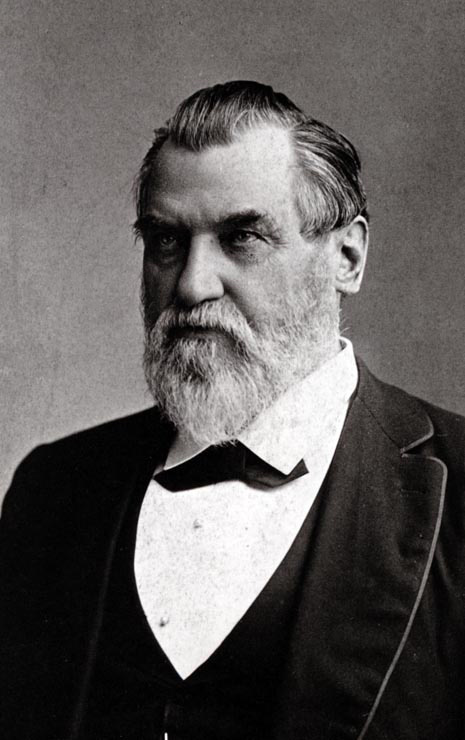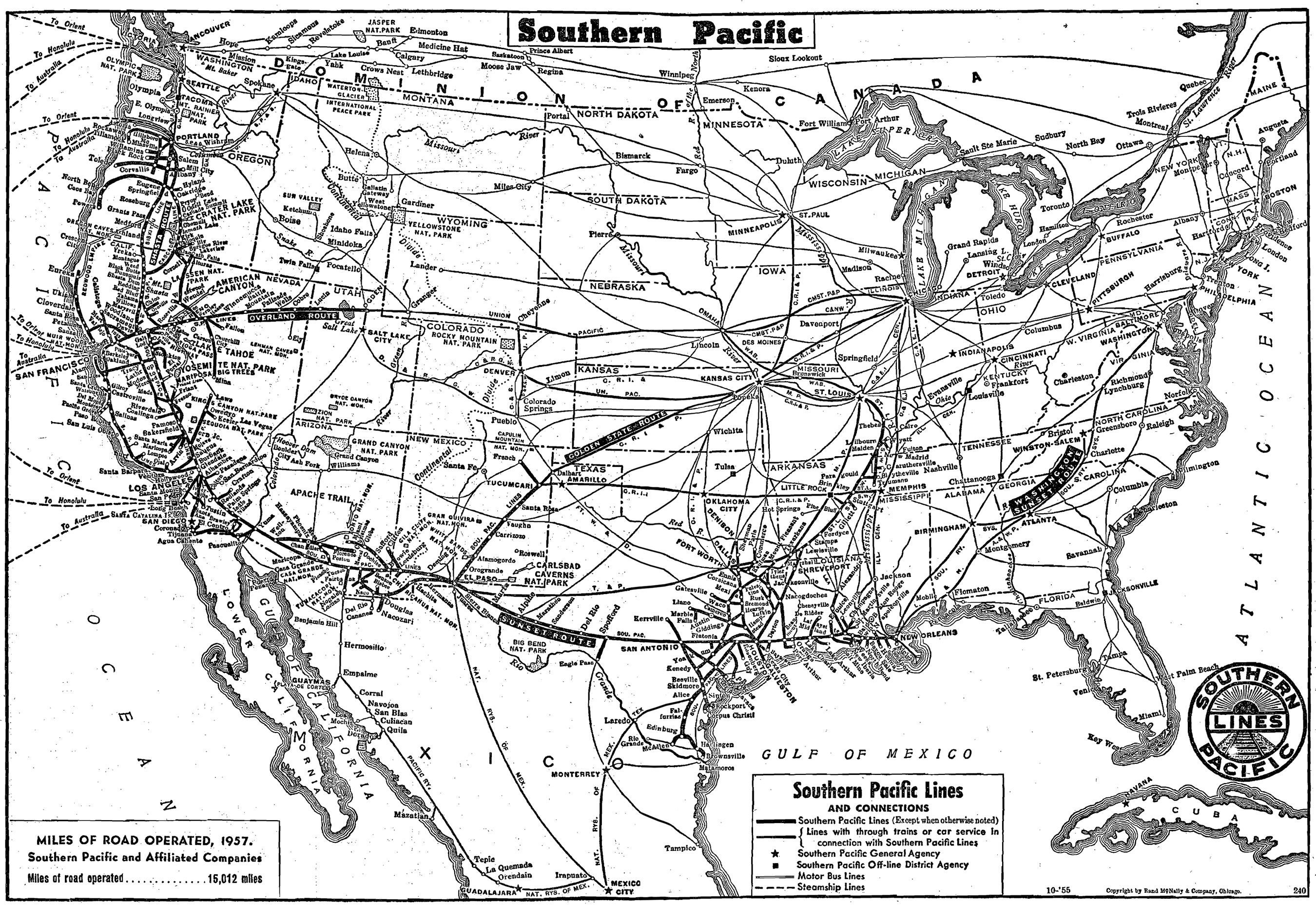Leland Stanford (Railroads): Net Worth, Industry, Facts
Last revised: February 23, 2025
By: Adam Burns
Leland Stanford was an American industrialist, politician, and tycoon who made his fortune as a railroad tycoon. He was one of the founders of the Central Pacific Railroad and served as its president.
Stanford was also a leading member of the Republican Party, serving one term as the Governor of California and later as a U.S. Senator.
He is perhaps best known for founding Stanford University, one of the world's leading research and teaching institutions, in memory of his son, Leland Stanford Jr.
Background
Leland Stanford, is remembered as part of the "Big Four" in financing the construction of the Central Pacific Railroad, which included (along with himself) Collis Huntington, Charles Crocker, and Mark Hopkins.
In terms of building the railroad, it was Stanford who helped secure much of the land grants and funding through the state of California as he held the governorship at that time.
While he had spent much of his early years studying and practicing law, much of his life after the California Gold Rush hit in 1849 was dedicated to operating business including railroads.
At A Glance
Josiah Stanford (father) Elizabeth Phillips (mother) |
|
Stanford played such a large role in the entire Central Pacific endeavor that is unlikely the railroad would have been completed otherwise. Interestingly, his career pursuits did not immediately begin in the railroad industry.
Instead, after earning his law degree in 1845 he began practicing in Albany, New York with the law office of Wheaton, Doolittle & Hadley. It was the Gold Rush which ultimately brought him to California in 1852.
Recognizing the great migration would offer bountiful business he opened successful mercantile establishments in Sacramento in 1856. It was here that he met the three other men of the so-called "Big Four."
Early Life
Amasa Leland Stanford, known simply as Leland Stanford, was born on March 9, 1824, in the modest farming community of Watervliet, New York. He was the fourth of eight children in his family. However, an unfortunate typhoid epidemic claimed the lives of Leland's three older brothers, thrusting him into the role of the oldest son.
Leland Stanford completed his basic education in local schools before reading law at Cazenovia Seminary in New York. Post studies, he moved to Albany, New York, where he worked in law offices and eventually was admitted to the bar in 1848.
Stanford's personal life echoed the glamour of his corporate endeavors. He married Jane Elizabeth Lathrop in 1850.
Their union, filled with both marital bliss and heartrending tragedy, shaped much of Stanford's pursuits in philanthropy, particularly their only child’s untimely death, which led to the founding of Stanford University.
In his early business career, Stanford operated a law practice and managed a general store with his brothers in Port Washington, Wisconsin, in the late 1840s and early 1850s. The Gold Rush's prospect lured Stanford to move to California in 1852, where he started a wholesale commodities distribution firm.
In California, Stanford ultimately became a successful merchant and wholesaler, a career trajectory that led him to cross paths with Collis Huntington, Charles Crocker, and Mark Hopkins.
This quartet, known in American industrial history as the "Big Four," played a fundamental role in the inception and construction of the Central Pacific Railroad.
Central Pacific
In the 1850s Stanford began to engage in politics, and is where he would eventually meet Huntington, Crocker, and Hopkins in 1856 (all of which were members of the Republican party).
Huntington, particularly, wished to see rails sprawling across California and helped establish the Central Pacific Railroad in 1861. In addition, with Abraham Lincoln winning the presidential nomination in 1860 the new CP ratified the Pacific Railroad Act to help complete the Transcontinental Railroad.
The Union Pacific was created directly as a result of the Pacific Railroad Act signed into law on July 1, 1862 and together the two railroads began working together to build from the east and west. For Leland Stanford's part, he was elected governor of California on September 4, 1861, which provided serious leverage for the CP's financing and construction.
Along with Stanford's efforts, the CP was also subsidized through the federal government (being given land grants as well as loans), mostly through Huntington's efforts.
Under Stanford's leadership, the project faced many significant challenges, including the Sierra Nevada's rugged terrain and labor shortages due to the American Civil War. However, Stanford and his partners managed to overcome these obstacles, in part by hiring many Chinese immigrant workers.
The Central Pacific Railroad and the Union Pacific Railroad met at Promontory, Utah, on May 10, 1869, marking the completion of the first transcontinental railroad in the United States. Stanford was chosen to drive in the symbolic last spike, colloquially known as the "Golden Spike."
The Central Pacific contributed significantly to the economic growth of the American West Coast, particularly in California. The railroad opened up vast opportunities for mining, agriculture, and other industries, making it a key factor in the region's development.
In September, 1868, Stanford and the rest of the "Big Four" bought out the original founders of the SP and would combine the operations of the Central Pacific by 1870. Stanford became SP's president and remained so until 1890.
By the late 1870s the railroad was sprawling out across Southern California and served the state's largest markets including its line through the Southwest, which reached El Paso, Texas by the early 1880s.
Throughout the rest of the 19th century the Espee continued to spread throughout the West and Southwest, reaching northern Oregon and serving most of that state's largest cities by the late 1880s. By the 20th century the railroad continued to expand and was by this time well entrenched into the Southeastern markets of New Orleans and the Gulf Coast.
By mid-century it owned a stunning 15,000 miles of track, stretching from the warm and sunny beaches of Southern California and Gulf of Mexico to the deserts of Arizona and mountains of the Sierra Range.
Legacy
Stanford wielded significant influence thanks to his vast wealth and multiple high-profile positions. He served two consecutive terms as the governor of California and later became a US senator. His political career aligned well with his business growth, cementing his influence on regional and industrial affairs.
However, his greatest legacy was arguably his philanthropy. After the death of his only son, Leland Stanford Jr., at 15, Stanford and his wife decided to use their wealth for the betterment of society. They founded Stanford University as a tribute to their late son, opening the university's doors to "all children of California" in 1891.
Stanford University
Stanford, as laid out in founding documents, aimed to create an institution that was responsible for promoting public welfare by exercising influence on behalf of humanity and civilization. Under his early stewardship, Stanford University developed into an exceptional educational institution, emphasizing a blend of practical teachings and academic theory.
Stanford played a direct role in shaping the academic and administrative policies of the university, often emphasizing the importance of multidisciplinary and innovative learning approaches. He ensured the university nurtured an open-minded, intellectual culture that would yield societal benefits.
Throughout his life, Stanford's net worth saw significant fluctuations. He was a businessman, politician, philanthropist, and an academic visionary. Upon his death on June 21, 1893, he left an estate valued at approximately $50 million, most of which was directed towards sustaining Stanford University.
Towards the end of his life, Stanford faced significant financial challenges due to various factors, including a nationwide economic depression in 1893. However, he persevered, securing the longevity of his cherished project, Stanford University, despite his declining fortune.
Leland Stanford left a lasting legacy, resonating far beyond his lifetime. His guiding role in the completion of the transcontinental railroad transformed the economic landscape of the West.
His political career was transformative in its right, but his educational endowment in Stanford University, which is globally recognized as a hub of innovation and learning, remains an indelible part of his legacy.
Stanford has also influenced every student passing through the university's halls and every researcher benefiting from its resources. The silicon valley, which owes its inception to the entrepreneurial spirit fostered by Stanford University, is a living embodiment of Stanford’s vision.
Leland Stanford’s story is intriguing because it is a chronicle of courage, resilience, adaptability, and dedication. Stanford, a man of humble beginnings, embarked on a journey that had significant ramifications across societal, cultural, and historical contexts.
Stanford successfully maneuvered through the Gold Rush era, a political career, the establishment of a groundbreaking transportation channel, and landed at the helm of an academic institution. His life is a testament to the timeless appeal of grit, determination, and the human spirit to continue reinventing itself.
Whether viewed as a pioneer in rail infrastructure, an influential politician, or a profound educationist, Stanford's impact is undeniably profound. His contributions echo down the annals of American history, reinforcing the importance of vision, innovation, and public service.
A closer look at Stanford's life reveals a man deeply committed to his causes. By navigating politics, business, and education, Stanford demonstrated an unfaltering dedication that etched his principles and ideals in the institutions he has shaped.
Stanford, with his enduring legacy, invites contemplation on broader societal themes and implications. His life amplifies the transformative power of vision, leadership, and philanthropy.
Leland Stanford's contributions spanning multiple spheres deliver invaluable insights into 19th-century America's society, economy, and drive. His life and achievements serve as excellent case studies for all those interested in American history, industrial revolution, entrepreneurship, and philanthropy.
The life narrative of Leland Stanford is filled with significant milestones and turning points. It amplifies the role of tenacity, creativity, and vision, affirming the belief that one person can indeed make a significant difference.
The story of Leland Stanford and his contributions paints a multi-hued portrait of a man who refused to accept the status quo. It serves as a poignant reminder of the power of vision and the fundamental role of human endeavors in shaping history.
Stanford's legacy created a unique narrative that binds personal tragedy with public success, creating contrasts that are testament to human resilience. His well-lived life encapsulates an essence of perseverance and creativity that scholars and researchers continue to draw inspiration from.
Notwithstanding the controversies and challenges encountered throughout his journey, Stanford's life is a testament to his unwavering commitment to creating and improving societal structures. His life illustrates the power of endurance, dedication, and a clear vision.
Stanford's life symbolizes the spirit of the 19th-century American Dream, speaking volumes about the possibility of achievement through determination and hard work. His life stands testament to how a person can leave a lasting mark in history.
The life of Leland Stanford stands as an invaluable reservoir for academia, research, and society. His story transcends its physical existence, narrating a timeless tale of innovation, evolution, socio-economic progress, and the relentless spirit of a remarkable man.
Leland Stanford’s life journey offers unique insights into socio-political realms, infrastructure development, and the world of education. His life and works continue to ignite intellectual pursuit and foster academic excellence, marking him as a major figure in the annals of American history.
No matter which way one looks at it, Stanford's life is a compelling narrative of overcoming challenges, forging peculiar paths, and making lasting contributions. His influence resonates beyond the confines of history, extending into the realms of culture, academic excellence, and sustainable development.
In conclusion, Leland Stanford’s life embodies a blend of entrepreneurial acumen, political astuteness, and visionary academic investments, which has left an undeniable imprint on American history. His life continues to inspire students, historians, entrepreneurs, and anyone with an interest in the evolution and dynamism of the American society and beyond.


